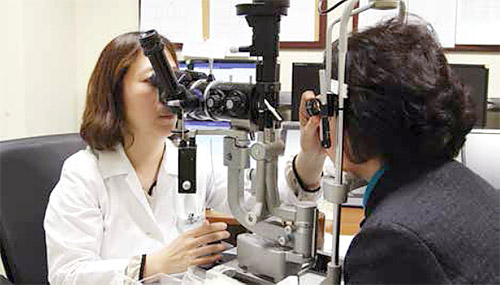Information
Medical News
| Silent Thief of Sight, Glaucoma; From Early Detection to Treatment | |||
|---|---|---|---|
| Attached File | 2018-07-13 | 1284 | |
|
Silent Thief of Sight, Glaucoma; From Early Detection to Treatment
- Professor Hae-Young of Ophthalmology Division, promising ophthalmologist of the future generations in glaucoma such as normal tension glaucoma and·glaucoma related to myopia, etc. -
- Concentrates on the development of drugs and surgical treatment with high rate of success for the maximization of the function of optic nerves and optic nerve regeneration -
Glaucoma is a group of ocular disorders in which optic nerves that send the light observed by the eyes to the brain are gradually damaged, and it is one of the three leading causes of vision impairment along with diabetic retinopathy and macular degeneration. According to the announcements of Health Insurance Review & Assessment Service, the number of glaucoma patients in 2013 was 627,325 and is increasing by 9.9% annually and it serves as a leading cause of blindness.
Glaucoma occurs when unusually high intraocular pressure damages optic nerves or when a disorder occurs in the optic nerve blood flow. At first, the peripheral vision decreases while the patient cannot sense it, and it gradually leads to blindness and it is hard to cure. The best option for minimizing vision loss is combining appropriate drug therapy and surgical treatment to slow the progress after early diagnosis.
“For glaucoma, prevention and early treatment are of paramount importance. Regular check-ups are necessary from 40 years of age, but if there is a family history, getting a check-up at an earlier period of time is recommended. In addition, if you have myopia or increased cup-to-disc ratio in your optic disc, have systemic diseases like diabetes, thyroid diseases, and any diseases that accompanies unstable blood pressure, regular check-ups are necessary.”
Professor Park Hae-Young graduated from the very cradle of ophthalmologists in the Republic of Korea, the Medical School, Catholic University of Korea. After becoming a specialist, she focused on glaucoma, especially normal tension glaucoma, glaucoma accompanied by nearsightedness, terminal glaucoma which will inevitably lead to blindness, refractory glaucoma (uveitic glaucoma, diabetes-related glaucoma) and is the promising ophthalmologist of the future generations in this field. In particular, Professor Park is concentrating on new treatment methods such as conducting researches on the causes of glaucoma, restoring optic nerves and developing drugs that can maximize the function of remaining optic nerves.
Among various kinds of glaucoma, normal tension glaucoma occurs due to damages of optic nerves although the intraocular pressure is within the normal range of (10~21mmHg). This is common among Asians such as the Koreans and the Japanese, and it accounts for 80% of all glaucoma in Korea. The causes can be largely divided into two categories; occurring because of the weakness of the supportive tissues of the optic nerve or because of poor and unstable blood circulation to the optic nerve.
“If it occurred because of circulatory disorders such as unstable blood pressure and insufficient blood supply within the optic nerves, the damages to the nerves take place at a faster speed. A lot of efforts must be put to intraocular pressure and blood circulation management in order to preserve vision as much as possible. Through optic nerve structure and function tests as well as intraocular pressure, we provide early diagnosing on the presence of damage on retinal nerve fiber layer, drug therapy and surgical therapy.”
Glaucoma accompanied by nearsightedness is relatively common among the young in Korea. In such cases, changes due to nearsightedness and due to glaucoma are interrelated in their influence.
“It is difficult to distinguish the effect of nearsightedness and glaucoma when treating optic nerves depending on the severity of damage. We are providing customized treatment to patients with glaucoma based on the results of various researches conducted to date.”
Professor Park is pushing harder to develop and study surgical methods that increase the success rate of glaucoma surgery. Terminal glaucoma nearing blindness or refractory glaucoma requires surgical treatment, and blindness depends on the surgical outcomes.
As such, Professor Park has already conducted various researches regarding normal tension glaucoma, glaucoma, glaucoma accompanied by nearsightedness, terminal glaucoma which will inevitably lead to blindness, refractory glaucoma and glaucoma surgeries, and published over 60 papers in the SCI journals.
“Glaucoma is often called the ‘silent thief of sight’. Regular check-up is the sole best way to maintain eye health. As a glaucoma specialist, I want to sympathize with patients, study the causes and develop treatment methods so that patients can overcome the danger of blindness.
2015.07.17 |
|||



 Inquiry
Inquiry Find Doctor
Find Doctor
